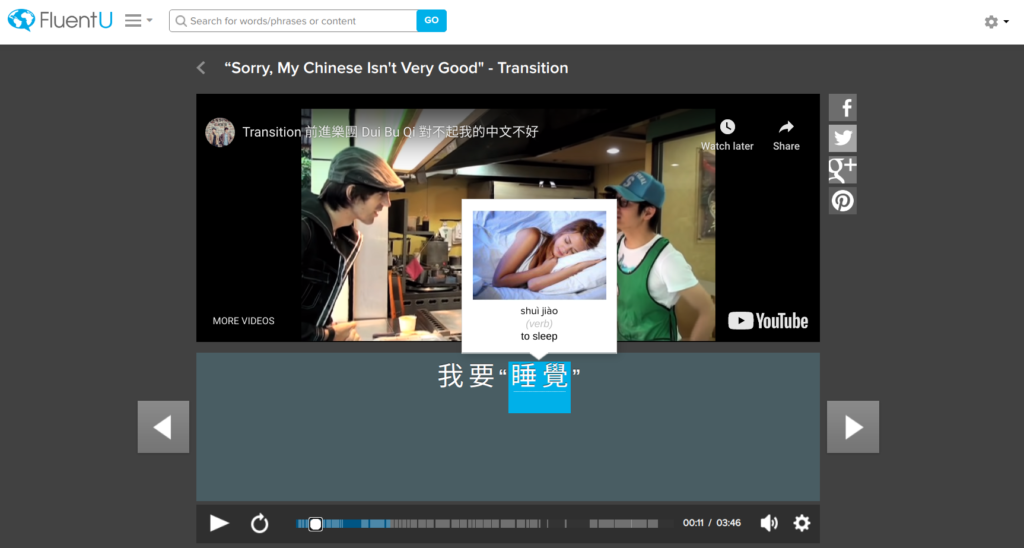 When starting to learn Chinese, most students are driven by a strong motivation to learn. But it is with language learning as it is with most long-term endeavours: the sheen wears off and studying the language is no longer the most exciting part each day. That doesn’t necessarily mean that it becomes boring, but it does mean that most of us need to make an effort to make it more interesting and enjoyable.
When starting to learn Chinese, most students are driven by a strong motivation to learn. But it is with language learning as it is with most long-term endeavours: the sheen wears off and studying the language is no longer the most exciting part each day. That doesn’t necessarily mean that it becomes boring, but it does mean that most of us need to make an effort to make it more interesting and enjoyable.
 One way of making learning more enjoyable is to focus on video content. Video is great because it contains the spoken language in context-rich and engaging environment, making it easier to learn. But finding videos you can just watch and understand in Chinese is a struggle for most learners; most clips are simply too hard!
One way of making learning more enjoyable is to focus on video content. Video is great because it contains the spoken language in context-rich and engaging environment, making it easier to learn. But finding videos you can just watch and understand in Chinese is a struggle for most learners; most clips are simply too hard!
This is where FluentU comes in. In a nutshell, FluentU serves you video and audio content through an interface that makes the language easy to interact with. It also offer ample support for the language you’re learning, including flashcards reviews, exercises and much more. While this review focuses on Chinese, it’s worth noting that FluentU offers ten other languages, including Spanish, French, German, Korean and Japanese.
If you prefer to watch a video review, I have created one here:
Let’s dig deeper and see what FluentU has to offer learners of Chinese!
Immersing yourself in 2261 Chinese video and audio clips
The videos are the core of FluentU and what sets it apart from many other services, including most podcasts. Using video to learn has obvious advantages, such as being more interesting, engaging more senses and offering more scaffolding.
The problem is of course that video is harder and more expensive to produce, so what FluentU has done is very clever: Turn existing videos into Chinese learning material. They also offer a growing library of videos created by the FluentU team, but more about that later.
At the moment, there are 2261 video and audio clips distributed over six difficulty levels, twelve types of content and eleven formats.
FluentU helps you find suitable content on your level…
One of the key features of FluentU is that it ranks all this content by difficulty, meaning how many unfamiliar words it contains. After you have used the service for a while, it will have a good idea of which words you know and can recommend content that is as easy as possible.
Naturally, you can sort the content in other ways, but the ability to suggest content that is as easy as possible is very important. Chinese learners tend to spend too much time on content that is too hard, not because they want to, but because they can’t find easier content! FluentU helps you out here by sorting clips based on what it knows about your Chinese level.
…and makes it more accessible!
The core of FluentU is the interface that lets you interact with the language in the videos. Without such an interface, it would be just like watching videos on any other platform that hosts video content. These features are very useful and go far beyond merely having subtitles. This is what it looks like.
You can play the entire clip, loop selected sections or pause the video simply by hovering over the subtitles. The video interface works well and allows you to drill-down into any part of the content you didn’t understand. There are also some extra features:
- Coloured time panel based on the subtitle content so you can easily find what you’re looking for or skip sections that has no spoken language in them.
- A loop function that allows you to play the same section over and over. This is very useful as listening more than once is much better than peeking at the subtitles.
- The option to toggle Pinyin and translations on and off, which is truly essential, but more about this later.
- Choose between simplified and traditional characters, regardless of the subtitles in the original clip.
Pop-up picture dictionary
Another great feature is the pop-up dictionary. This is not your average browser pop-up dictionary that simply gives you a standard definition and the pronunciation of the character or word you hover over, it gives you much more than that.
As the screenshot on the right shows, you also get a picture and the part of speech. The pictures are surprisingly well chosen to illustrate the specific words, although not always perfect. Still, this is as far as I know the largest dictionary that includes images like this.
While we’re at it, let’s look closer at the vocabulary, because this is one of the areas where I think FluentU really stands out. If you click on a word, it brings up more information about it:
There are a couple of really cool things here. First, there are numerous example sentences with translation and audio. Most of these are actually quite good, although there are exceptions where the example sentence contains vocabulary that is much harder than the word itself.
Second, some of these sentences have video, which is surely unprecedented in other Chinese learning materials. This means that you can actually watch how that specific word is used in other videos on FluentU! If you want to hear how real people say a certain word, you can quickly get an idea by click on the videos, which takes you to the segment where that word is used.
You can of course add vocabulary to study and review later. The only drawback with the vocabulary screen is that the audio is synthesised, which is better than nothing, but not recommend for pronunciation practice in general or beginners in particular.
A review of FluentU’s Chinese content
As mentioned above, the content is partly from YouTube and partly created by FluentU. The former is very diverse and everybody should be able to find something they like. Most of the videos are short, often less than a minute.
This is good for bite-sized learning, but can also be quite annoying if you want something longer and more coherent. To address this problem, videos are also organised into courses, which focus on a specific topic.
The videos created by FluentU are of varying quality, both in terms of scripts, acting and recording quality. Some videos for beginners come across as very unnatural and are, to be honest, quite bad. Here’s an example:
Compare with this one, which is better in every way imaginable:
These videos are available on YouTube, so if you’re just after this kind of content, you can access it for free. However, note that much of the content on their channel is just still images with audio, not actual video production like the two above.
Naturally, the point of FluentU is not the videos themselves, but what you do with them, so let’s have a look at that.
Learning Chinese vs. just watching videos
Just sitting back and watching videos with subtitles in English and Chinese isn’t very effective for learning Chinese. You need to be more active than that, which is supported by FluentU, but not mandatory.
Her’es how I suggest you watch videos:
- Select a video where you already understand almost everything
- Watch it without subtitles a few times; make a serious effort to understand
- Watch it with subtitles in Pinyin or characters, depending on your goals
- Turn on translations and check your understanding
- Study the vocabulary you find interesting or useful
If you’re a big fan of bottom-up learning, you can of course reverse the process and look up vocabulary before you dive in, but I strongly advice against it since that is far removed from real-world listening. One of the strengths of FluentU is the authenticity of the listening practice available. You learn to understand spoken Chinese by really trying to understand spoken Chinese, not by studying a transcript in advance.
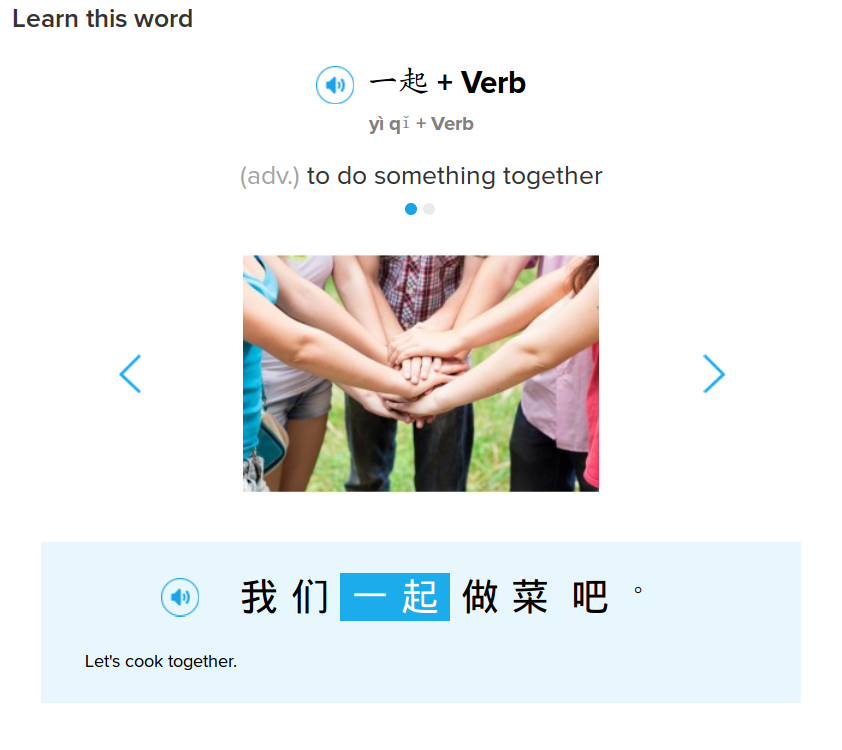 The learning mode consists of a series of questions where you pick the right translation, select Pinyin, fill in the gap, type characters and so on. You can also view the word in different contexts, just as you could with the pop-up dictionary in the video player. In general, this section of the site makes sure you’re actively processing the content, rather than just watching it.
The learning mode consists of a series of questions where you pick the right translation, select Pinyin, fill in the gap, type characters and so on. You can also view the word in different contexts, just as you could with the pop-up dictionary in the video player. In general, this section of the site makes sure you’re actively processing the content, rather than just watching it.
Flashcards and vocabulary reviewing
 If you want to learn something, you have to review it. FluentU has a built-in flashcard system based on a spaced repetition algorithm. They don’t disclose much about it, except that it’s based on Supermemo. In any case, it’s all integrated into the system so you can review words from the videos you have watched FluentU will try to direct your attention to words you might be about to forget.
If you want to learn something, you have to review it. FluentU has a built-in flashcard system based on a spaced repetition algorithm. They don’t disclose much about it, except that it’s based on Supermemo. In any case, it’s all integrated into the system so you can review words from the videos you have watched FluentU will try to direct your attention to words you might be about to forget.
What I like most about the flashcard system is that it keeps everything in context. I have mentioned this several times already, but it’s truly awesome to be able to see the word used in different sentences and the videos in which they appear.
There are also apps available for both iOS and Android. I’ve only tried them out briefly and found that they didn’t work as well as the website, but having a mobile solution is essential for efficient vocabulary reviewing.
Subscriptions and pricing
FluentU adds value to other people’s videos through a smooth interface, and they help you engage with the language found in the videos. They also offer their own videos, so it’s definitely something you should expect to pay for. A lot of work has gone into both the interface and the content, particularly the dictionary parts (all the pictures, for instance). Yes, you are watching content that is free, but what you’re paying for is the structure and functionality to make it accessible and learnable.
Prices are subject to change, so please refer to the official site for up-to-date information. At the time of writing (October, 2020), there is only one type of subscription, which you pay for monthly ($30/month) or annually ($20/month). You can also downgrade to a free, limited plan.
You can make use of a free trial, of course, but they ask you for your payment details up-front, just so you know. This is not popular with the mobile apps, that have horrible ratings on both iOS and Android. However, if you take the time to browse through the reviews, you will find that almost all who complain do so because you have to enter payment details up front, not because the apps themselves are bad.
Is FluentU worth the price? That’s hard to say, as it depends on both how much value you get out of the service and how much value each dollar has for you. If you’er a cash-strapped student looking for some extra listening content, there are many other services that are cheaper or even free. But if you want the whole solution in one package centred around videos and you regard $20 a month as the cost of a single tutoring lesson, then it could very well be worth it for you.
Room for improvement
 No review would be complete without bringing up a few points of concern. It should be clear from the above discussion that I think FluentU is well worth checking out, but that doesn’t mean that it’s perfect. Far from it. In fact, I have a few fairly serious concerns about FluentU, especially for beginners.
No review would be complete without bringing up a few points of concern. It should be clear from the above discussion that I think FluentU is well worth checking out, but that doesn’t mean that it’s perfect. Far from it. In fact, I have a few fairly serious concerns about FluentU, especially for beginners.
- Difficult to integrate – Some learners don’t want or don’t need a complete solution, especially if it isn’t complete (and no solution ever is). That means that being able to integrate FluentU with other ways of studying is important, but they really don’t want you to do that. For example, there was no vocabulary export function five years ago and there still isn’t one. If you want to use Skritter to write the characters or look something up in Outlier’s Dictionary of Chinese Characters, your only option is to do it manually.
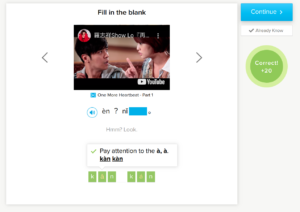 Pinyin exercises are a travesty – In FluentU, you can choose if you want to learn characters and/or Pinyin. That’s great, as I think people should be able to focus on the spoken language first, and this is a good way to do so (good luck finding Pinyin subtitles for videos elsewhere with all the functions I’ve introduced above). However, the Pinyin exercises require you to type Pinyin but don’t require you to type tones. That’s already bad, but what makes it a travesty is that you can even enter the wrong tones, and it will still say that you’re correct! A small popup where it shows the correct tones is not an acceptable solution. My criticism here might sound very harsh, but I can’t tolerate Pinyin without tones in a learning situation. Tones are not optional!
Pinyin exercises are a travesty – In FluentU, you can choose if you want to learn characters and/or Pinyin. That’s great, as I think people should be able to focus on the spoken language first, and this is a good way to do so (good luck finding Pinyin subtitles for videos elsewhere with all the functions I’ve introduced above). However, the Pinyin exercises require you to type Pinyin but don’t require you to type tones. That’s already bad, but what makes it a travesty is that you can even enter the wrong tones, and it will still say that you’re correct! A small popup where it shows the correct tones is not an acceptable solution. My criticism here might sound very harsh, but I can’t tolerate Pinyin without tones in a learning situation. Tones are not optional!- Text-to-speech inadequate – While the text-to-speech engine used in the current version of FluentU is orders of magnitude better than the one included when I first reviewed FluentU in 2015, it still sounds robotic. It’s reached a level where it’s certainly better to have it than to do away with it completely, but this is still an issue. As a beginner, you will rely on the dictionary for help and you should not learn pronunciation from a synthesised voice. This becomes less of a problem the more you focus on the videos themselves. A good example of the shortcomings of the text-to-speech engine is that it really can’t handle neutral tones, which sometimes have hilarious and embarrassing effects. Take a look at the video on the right, for example.
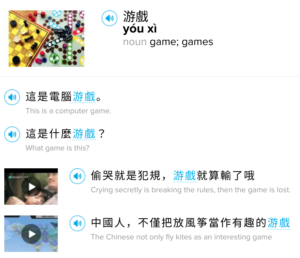 Inadequate support for traditional characters – As is the case with many services, traditional characters aren’t handled very well. If you search for a word in traditional Chinese, you find the vocabulary in simplified, with no mention of the traditional variant. For example, 遊戲 is incorrectly written as 游戏i, including in sentences. This would be truly frustrating if you want to learn traditional, as I’ve from several students who use FluentU (see the comment section for one example). I know from my work over at Skritter that maintaining neat relationships between simplified and traditional Chinese takes a lot of effort, and I’m reasonably sure everything in FluentU is automatic in this regard, and hence, not very reliable.
Inadequate support for traditional characters – As is the case with many services, traditional characters aren’t handled very well. If you search for a word in traditional Chinese, you find the vocabulary in simplified, with no mention of the traditional variant. For example, 遊戲 is incorrectly written as 游戏i, including in sentences. This would be truly frustrating if you want to learn traditional, as I’ve from several students who use FluentU (see the comment section for one example). I know from my work over at Skritter that maintaining neat relationships between simplified and traditional Chinese takes a lot of effort, and I’m reasonably sure everything in FluentU is automatic in this regard, and hence, not very reliable.- Lack of structure and guidance – This comment is only relevant if you want to use FluentU as your main source of learning. Where should you begin? Some videos are linked together into courses, but it’s still haphazard. There’s nothing like a golden path that you can stick to if you don’t want to make too many choices yourself. Should you learn all the words? No, you most definitely should not, but how do you know which to learn? If FluentU wants to become a complete solution for learning Chinese, it needs to guide learners more. Yes, being able to choose interesting content is great, but too much choice has its own problems, especially for beginners.
- Doesn’t work in China – This should be obvious since the service is mainly based on YouTube videos and those are blocked in China. You might be able to get around this, but from what I gather, that creates delays that are so serious that it’s not worth it. If you know more about this, please leave a comment!
That being said, FluentU is really good at the core concept: making engaging content more accessible. I have discussed FluentU with many learners who are very happy with the service and have used for years. If you check the comment section below, which includes comments from my old review, you will see that for some people, FluentU offers a great way to stay motivated and learn more!
An impressive blog for learning Chinese
While this is not part of the core features or even the paid version of FluentU, I would like to mention that FluentU has a very impressive blog for Chinese learners. While I personally don’t like click-bait titles, the content is often very good (and I don’t only say that because I used to write articles for them many, many years ago). There are plenty of articles about all sorts of things related to learning Chinese, and while it’s natural to expect some promotion of their services, I can recommend the blog even if you’re not interested in learning Chinese through videos.
Conclusion of my FluentU Chinese review
I think FluentU is a valuable resource for learners of Chinese. It’s largely the same service that I reviewed five years ago, but some things have improved greatly. If you like video content, but feel that just watching random videos doesn’t work for you and you need more support, you should check it out. While you do need to enter payment details on sign-up, there is a trial which is free as long as you cancel in time.
The big question is if it’s worth the money. As I’ve already said, the answer will vary. For some, paying $20/month for this services is exorbitant, but for others, it’s an investment that gives them access to enjoyable learning, which could be worth more than that.
What do you think about FluentU? Do you agree with my overall review? I’m not really in the target group of learners, so I would love to hear what beginners and intermediate learners think about FluentU. Please leave a comment below!
Disclaimer: This article contains affiliate links. That means that if you try FluentU using one of the links in the article and end up subscribing, part of your payment goes towards supporting Hacking Chinese. I always review services as fairly as I can, affiliate or not, as can be clearly seen in the “room for improvement” section above!
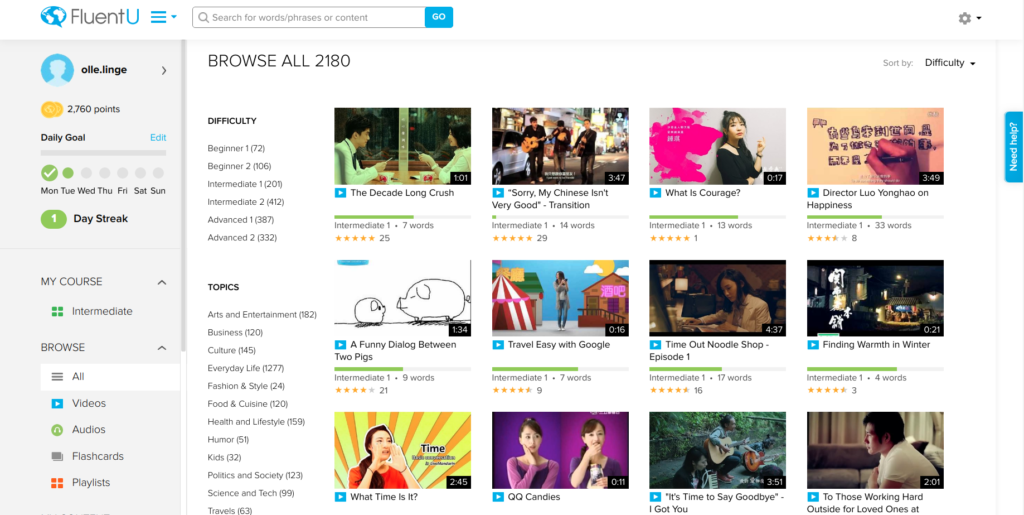

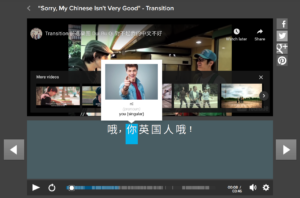
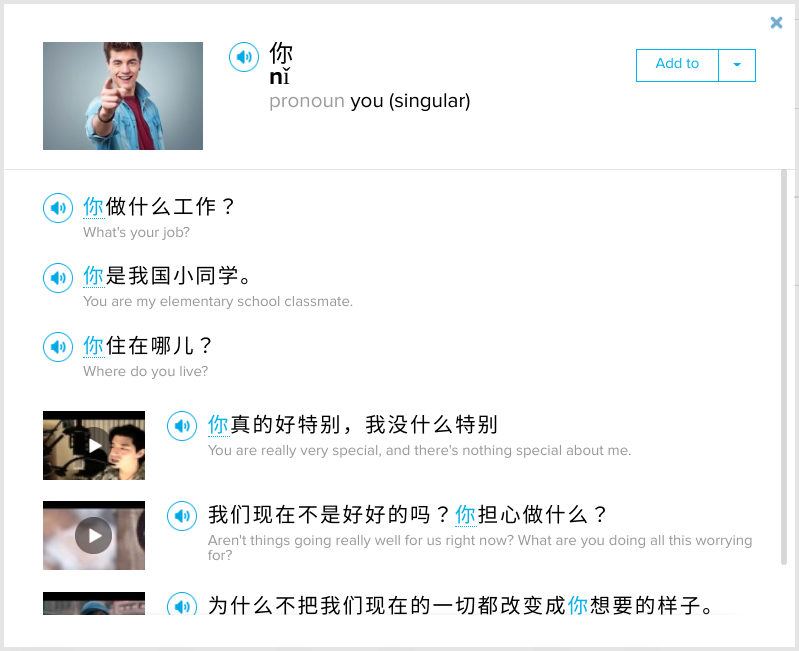

17 comments
Ollie, I have been a Fluentu iPhone app beta tester for over 6 months and can add a lot. As background, I have never taken a formal class in Chinese, but my wife is Taiwanese. The interface to learn Chinese is truly awesome, and the content once you get past the newbie level is pretty good, certainly better than what you get from other sources. I have recently upped my level to intermediate, and certainly the content is harder and takes time but you can master it. I’ve learned 4 Chinese songs so far. I recommend the service to anyone as very helpful. However, there are two major issues: 1) Fluentu is awesome for passive Chinese (reading and especially listening), but it does not help your speaking in particular and we know how important tones are. In addition, learning the tones of the words you learn to me is the hardest part, and Fluentu could GREATLY improve in this area. I.e. I know guaiwu the character and word (怪物) but not its tones. Also, Fluentu cannot address your pronunciation, and my wife says my tones are terrible. In general it cannot as much help active Chinese (the spoken, typed, written Chinese that you produce). The service could be improved by forcing you to produce Chinese and somehow evaluate it. The second issue is particular to traditional Chinese learners: the service simply gets words wrong. You provide the right answer and it says you are wrong; it misreads the Traditional character that you correctly put in. That is bad; what worse is since it is SRS, it CONSTANTLY quizzes you on it since it says you are wrong. Very annoying. Your comments on the robotic speech and wrong tones is interesting as well. Still the service is recommended to anyone who wants to do independent learning. Any comments from you on what tools I can use to improve pronunciation (pleco tone quizzes? — super ideal if your vocab list could integrate with Fluentu — but so far it cannot) would be welcome.
Mason (魏梅森)
Thank you for sharing your thoughts, you’ve used FluentU much more than I have and it’s interesting to hear what you have to say. Regarding traditional support, I do Chinese language support for Skritter, so I know how bad it is if you rely on automatic conversions (I fix dozens of those every week).
When you say pronunciation, do you actually mean listening? You can use Pleco or Anki. The latter is very flexible and you can set up audio-only cards. Since you can’t export anything from FluentU, it’s hard to integrate it with anything else, though, which is a problem. You could just not use the flashcard part and use an external program for that, although that’s far from ideal.
The notion that you can depend on automatisation from simplified characters or, for that matter, on non-users of full-form characters (many of whom are also ignorant of other Chinese languages – itself an obstacle to understanding) when these are your preference is the reason why I’ve rejected such outlets as FluentU, so-called dual-character dictionaries and Skritter. It just isn’t worth my while fixing other people’s errors, even if I do notice them. Frankly, I’d prefer a warning at the top of your reviews, Olle: NOT FOR TRADITIONAL CHARACTERS or something similar. (I know that you use both, but hey – we’re not all intending to teach this language.) That way, I’d save myself the frustration if having a cutting-edge tool recommended, only to find it’s only available to me with a wooden instead of a steel blade.
Well, different people care about different things, so I will keep commenting on how traditional characters are handled, but not likely at the top. Some kind of short summary, maybe, so you can see pros and cons at a glance?
When it comes to supporting traditional characters, I think few people realise how much work it involves. Many people (not you in this case) seem to think that it’s just a matter of flipping a switch or something.
When it comes to Skritter, I can certainly understand if you think that it doesn’t do a good enough job (it’s far from perfect, like I say in my review as well), but we have spent literally hundreds and hundreds of hours on support for traditional characters. That’s expensive, so most companies don’t really bother. I’m not saying that this makes it okay to not care about traditional characters, just that we’re talking about serious amounts of time and money invested to make it work well.
As someone who focuses on traditional characters (along with simplified, but traditional is still what I prefer and what I would choose myself), I try to evaluate how good or bad it is in the apps I review. Simply saying that “it’s not great” doesn’t help, because that would be true almost every service. I know of hardly any learning app that can deal with simplified and traditional characters really well (if you do know of such apps, please let me know). This is regrettable, but understandable.
There’s a big difference between machine conversion all the way and what Skritter does, though, just want to point that out!
I have been a (paying) fluentu user for a few years now. I think it is a very good product, well worth paying for. However is it not the only tool I use for learning Chinese. I use skritter on a daily basis and what I miss most is that I can not integrate the new vocabulary from my fluentu videos into my skritter word database. Even a simple export function would be fine. But now there is nothing.
Fluentu is great for improving your listening skils, give you an good insight into ‘real life’ chinese and also link the vocabulary and the new phrases that you learn to context. This not only makes it easier to remember the new stuff but it also provides this precious cultural insight that learns you to use the right words in the right circumstances, something you can never really get out of a dictionary.
I usually read the transcript first so that I have at least an idea what the clip will be about. Then I watch the videao a few times and try to understand the content. After that I study the video online. This takes a long time. In the beginning I thought that there were far too many exercises, fluenty really makes you work at every word, every sentence. But the advantage is that you just study automatically, while you do the work. With other methods, especially textbooks, I often have the feeling that the exercises are there as some kind of test, expecting you to have learned the vocab, expressions, etc, by rote and then just reïnforce what you have learned with the exercises. Fluentu really makes you work at it and so I find that I don’t need to do anything else than just go through the whole set. At my level (upper intermediate) this often takes more than one hour.
I don’t use the flashcard system, I just allow myself to eventually ‘forget’ some words that I learned. In Skritter I have several frequency based lists and all the HSK lists as a basis so I just expect that all the words that I need to become fluent in Chinese will eventually show up there.
Marc
Thank you for sharing your experience! I completely agree with you about the importance of being able to export properly, which is why I wrote the comment about it not being easy to integrate. I don’t want a complete solution, I want a service to solve a couple of problems or provide for a few needs. Then it needs to be able to work with the other solutions I have. I don’t want five different vocabulary review services! Other people might want a more one-stop solution for learning, but I’m not one of them and most independent learners won’t be either.
How does it stack up against the usual problems with Chinese learning services?
1) A ton of advanced content, and only a few beginner videos. Staff considers creating novice content beneath them.
2) Teaching students Taiwan Chinese without identifying it as such, leading to bewildered looks when used in China.
3) I seem to remember when this one came out, and really questioned the youtube integration seeing that it’s blocked. Is it really unusable? Sad they went down that path, seems completely avoidable.
Good questions! The first might have been a bigger issue earlier in the development, but not so much now. To start with, there’s lot of beginner content on YouTube and they use that. I think this is a bit dubious, to be honest, but I guess they know what’s legal. It just feels strange when someone else produces a high-quality beginner-friendly video (teaching you Chinese, not just dialogues) and then you import that into another service to teach your students. In any case, there’s plenty of beginner material there. It’s definitely not the case that the staff thinks it’s beneath them, though, lots of the custom-made videos and audio are for beginners.
Regarding your second point, since the videos are from all over YouTube, you get all kinds of dialects and accents. Sure, YouTube is blocked in China, but there’s still a lot of Mainland material there. I haven’t tried to count, of course, and I don’t think they have either. However, you’re right in that the dialect used in each video isn’t labelled. I also think the custom-made material is produced in Taiwan, but having learnt most of my Chinese and spoken with plenty of Mainland Chinese, I have never thought this a big problem.
Finally, regarding speed issues while using a VPN, I have no personal experience of this. My comment about that was based on what I have seen other people say about it. If anyone has managed to get it to work well in China, please let the rest of us know!
I have just started the Plus plan, after some time as a non-paying member and scarcely using FluentU.
There seems to be no explanation anywhere of how their system works. Why does it say I have learnt 53% of the video and refuse to go further? How do I get out of the Help section (which contains no introduction to the system) and back to videos? What happens if I say I already know a word – what effect does it have?
A lack of help in the program (although I can see it will be very useful to me).
I really like Fluentu, or at least the idea behind it. I’ve been using the free version on and off for a year or two and it has helped me some, although I expect it would have been much more helpful if I’d been using the paid version consistently over the same period. I don’t expect I’ll ever be willing to pay a monthly fee, though, for a service I consider supplemental. All of the videos are already available on Youtube, but mostly without the Chinese/English subtitles. I think that once you reach a certain level, you might be better off just watching the videos on youtube and perhaps try to write down your own transcript.
The biggest issue for me is the google plugin they use for typing Chinese. As Mason Wev says it doesn’t support traditional characters very well. As I’m learning traditional characters, I try to limit my exposure to simplified characters as much as possible, and Fluentu does make this a bit hard when it requires me to type simplified Chinese when reviewing vocabulary. I believe this is because they’re using a Google plugin for typing characters, so I don’t expect much improvement here anytime soon.
Being unable to export is a major shortcoming, especially because the flashcard system used by FluentU cannot be customized. Their flashcard system is incredibly slow—using Anki, I can study several dozen words in a few minutes, but on FluentU, those several dozen vocab take several dozen minutes. The context is nice, but I don’t appreciate not being able to control how I use the flashcards.
I was able to scrape my vocabulary off the website into a google spreadsheet and import that into Anki, so problem solved.
There are other issues, such as “mastering” a video takes countless repetitions of the flashcards, which is absurd. I made a macro to repeatedly run through the learning section for an advanced video I felt comfortable with, marking everything as “already known”. It took dozens upon dozens of learning sessions. Holy crap.
Supposedly, the upside of marking things as “already known” is it helps your video recommendations, as the little blue bar underneath will show you how much of the video you know and how much you don’t. However, as far as I can tell, the algorithm used by FluentU sucks for SRS. Then again, the algorithm may view “mastering” a video in one day unfavorably, but if I’m a native speaker, it shouldn’t take so much effort to tell FluentU what I know.
Room for improvement while watching videos:
1. Left-click: “Mark as known”
2. Right-click: “Mark as unknown”
3. Double right-click: “Bring up more information about the word.”
4. Option to set entire sentences as known automatically.
5. Shortcut to set current sentence to known.
How did you scrape you vocab off? I need to do this and I can’t figure it out.
I hate their revision implementation. It is both slow (I live in China, so it has to be at the mercy of my VPN as well as being slow generally), many of the revision sentences they present the words in are full of words I have never encountered, and the timing is overwhelming. I want to migrate my list to Anki or Pleco.
For completeness for anyone else who finds this post like I did, try the Chrome extension Data Miner Pro. With some fiddling about it will let you download your current lists.
Thank you for sharing! I’m actually looking into updating this article and it’s somewhat dismaying that it’s still not possible to export vocabulary. I’ve always had a problem with apps that try to do too much, or that are very good at one thing, but then insist of doing other things in-house even if it’s not up to par. I have’t tried FluentU for a while, so I’m not saying they’re guilty of this now, but it was the case last time I checked.
FluentU seems to have really gone downhill. It is now quite expensive and there is, as far as I can tell, no free trial, or even a monthly option. I tried emailing the administrators, but got only boilerplate in response. It was a good idea, but $$ seems to have trumped education.
They seem to have doubled the price compared to when I wrote the review! I think there are still monthly options, though. I agree that $15/month for just the basic plan and $30/month for the plus plan is definitely expensive. Do you know if it’s just a price increase or if there’s new content as well?
cool article